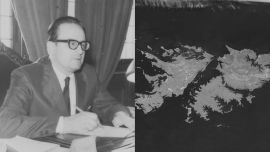If last Saturday’s column was dedicated to the upcoming 70th birthday of Vice-President Cristina Fernández de Kirchner, today’s famous birthdays include her husband and presidential predecessor Néstor Kirchner – what a family with three of the four born within nine days of one another (with Máximo turning 46 on February 16)! Yet unlike his wife last weekend, Lupín is in no position to hog all the birthday glory because February 25 also saw a rather more revered name enter this world – el Libertador General Don José de San Martín (also, among others, my favourite Beatle George Harrison but since this is an Argentine column, he will make no further appearance in this space).
Today’s column will thus centre on Néstor Kirchner (1950-2010) and José de San Martín (1778-1850) but since both are male, first a stab at gender balance in keeping with the times. No woman of striking historical or current importance was born locally on today’s date – unless Frente de Izquierda y de Trabajadores (FIT) leftist deputy and likely presidential candidate Myriam Bregman (who turns 51 today) surprises everybody with a landslide victory come October. But there was one female death on today’s date which is interesting, both because of the person and the circumstances. Julieta Lanteri was a feminist doctor who was the first woman to vote in Argentina in 1911 (37 years before female suffrage) since the ban on women voting was considered so self-evident that it was omitted in the letter of the law and when that omission was corrected for the electorate, she ran as a candidate for Congress in 1919 because the loophole persisted at that level. On February 25, 1932, she died two days after being run over on the Diagonal Norte – yes, reader, there were also motor accidents nine decades ago. But was it an accident? The driver David Klappenbach belonged to a paramilitary grouping and an extreme rightist running over a leading progressive figure looks like too much of a coincidence but it was the “infamous decade” and her death stayed filed as an accident.
Turning to San Martín, it has always baffled me that August 17 should be the public holiday to commemorate the father of the fatherland and not today – surely his birth in his homeland 245 years ago today is what should be celebrated and not his disillusioned death in the faraway English Channel port of Boulogne. Not that Argentina can claim any monopoly on a man who also liberated Chile and Peru and who only spent 12 of his 72 years in this country. Another problem with San Martín is that he has become so enshrined in “Saint of the Sword” marble that his human dimensions become hard to grasp. In this day and age without secrets or mysteries it might have been otherwise – thus his marriage to 14-year-old Remedios de Escalada might lead to his being branded as a statutory rapist or even a paedophile in social network gossip although applying such anachronistic criteria would, of course, be absurd.
But anyway this column is not just about San Martín but also the other birthday boy Néstor Kirchner. The question arises whether the two men had anything in common beyond their date of birth. Could they each be considered a foundational figure of their respective centuries? That view might be accepted by many in the ranks of the current government but widely rejected beyond – instead of freeing a colony from an oppressive state and turning it into a nation, Néstor Kirchner reverted to an oppressive state by setting a ball rolling which doubled public-sector employment and the tax burden, it might be argued. To which the “national and popular” ideology might claim to be new liberators from a new colonialism. And so on.
What fogs this comparison is that Kirchnerism remains an unfinished story (and nobody should assume that they will inexorably lose the upcoming elections) while San Martín was so long ago. If the 20th anniversary of Kirchner’s inauguration is coming up within a few weeks, perhaps the comparison with Kirchnerism today should be made with San Martín in 1833 – with the glory years between 1813 (his first victory at San Lorenzo) and 1821 (his capture of Lima) long behind him, he could only contemplate from afar in France how two decades of caudillo warlords were degenerating into outright dictatorship under Juan Manuel de Rosas. San Martín’s life was thus ultimately a failure while his legacy was ultimately a success.
By way of contrast, the Néstor Kirchner 2003-2007 presidency was a huge success leaving a highly controversial legacy still awaiting the last word – arguably the best macro-economic indicators in Argentine history with “Chinese” growth rates, the twin fiscal and trade surpluses and in general data which did not need doctoring by Guillermo Moreno’s INDEC national statistics bureau intervention until the last 10 months of his presidency. In that sense he reminds me in some ways of Bill Clinton, who also enjoyed among the best macro-economic indicators in United States history but left a very small footprint – except that some critics would argue that Kirchner’s footprint was all too heavy.
Not much space left for personal memories. In last Saturday’s column l already described my one face-to-face encounter with Néstor Kirchner at a German Chamber of Commerce anniversary event when he mistook me for a top German businessman. But no memory stands out more than the day of his death (the 2010 census day of October 27) which found me in Calcutta walking down a main street when I suddenly passed a television shop with Néstor Kirchner’s unmistakable visage on 50 screens and could not believe that he had followed me 16,500 kilometres away until I found out what had happened. But anyway today is February 25, not August 17 or October 27.





















Comments